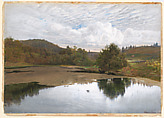Leith Hill from Broadmoor, Surrey
Edmund George Warren British
Not on view
Warren was one of the first to apply Pre-Raphaelite principles to watercolor landscapes. The year he made this work, a critic in the Athenaeum described him as an artist "who painted what he saw . . . [and] loved an English lane or wood-side . . . water bright, flashing and sheeny, and grass green, rain-beaten or wind-shaken." The compelling composition centers on a pond below Leith Hill, the highest point in southwest England. To help distinguish water from sky, the artist represented an orange-billed duck pursuing a dragonfly and rippling the reflective surface. Floating weeds behind give way to textured foliage growing over a rising slope, with Leith Hill Tower at the crest acting as a small punctuation point to direct the eye toward mottled clouds.
Due to rights restrictions, this image cannot be enlarged, viewed at full screen, or downloaded.



